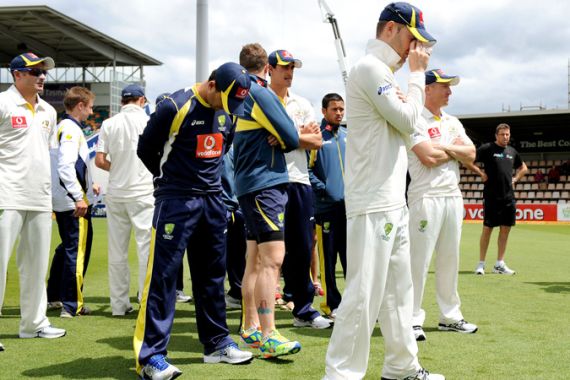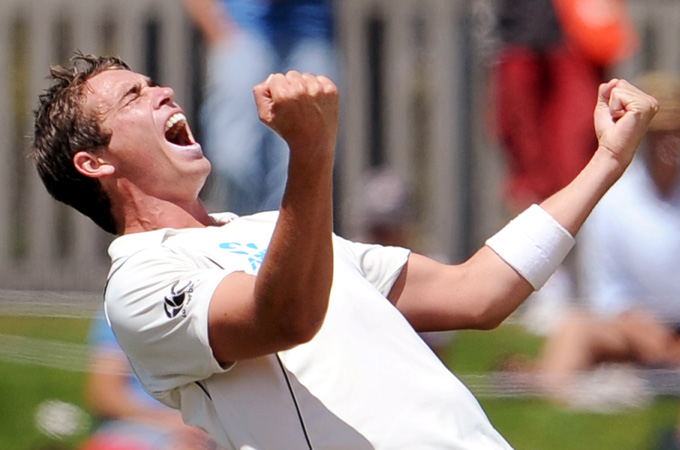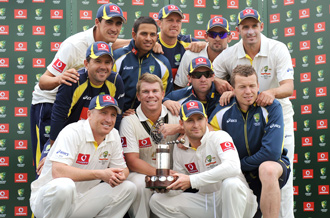Inconsistency blights Australian cricket team
Australia’s loss to the Kiwis was branded a ‘disaster’ by critics but Michael Clarke’s team have been improving.

 |
| New Zealand paceman Tim Southee celebrates taking a wicket during his team’s historic victory [AFP] |
Michael Clarke’s lineup has just taken one dramatic step in reverse after a couple of shuffles forward since they were branded the worst Australian Test lineup in decades.
In the latest setback, New Zealand ended their long drought by winning a Test on Australian soil for the first time since 1985 with a tense seven-run victory Monday at Hobart’s Bellerive Oval.
Keep reading
list of 4 itemsNew Zealand ease to seven-wicket win over Pakistan to level T20 series
Pakistan and New Zealand T20 abandoned due to rain after two balls
Australia’s Smith joins Washington Freedom before MLC cricket season
The manner of a collapse from 159-2 to 233 all out chasing 241 for a 2-0 series sweep had echoes of that innings at Cape Town last month when the Australians were bundled out for 47 in a heavy loss to South Africa that drew plenty of harsh criticism.
|
“We can’t seem to find that middle road. We’re inconsistent at the moment, which is a real pain” Michael Clarke |
The two Test wins in the interim at Johannesburg and again last week in Brisbane, it seems, were aberrations.
With a four-Test series against India starting December 26, Clarke and his fellow selectors need to make some tough decisions following a loss to the No. 8-ranked team in Test cricket.
“You’ve seen some really good patches of individual excellence, and as a team we’ve been playing really well in patches,” Clarke told a post-match news conference.
“But then you’re seeing the other side as well, where we’re letting ourselves down by very poor performances.
“We can’t seem to find that middle road. We’re inconsistent at the moment, which is a real pain.”
‘Low point’
The headlines online were full of adjectives such as “disaster” and “embarrassment” even before Clarke left the field.
Analyst and former Test captain Ian Chappell told the website cricinfo the result “was a bit of a low point” for Australian cricket.
Only Clarke, who scored three centuries in his six innings coming into this Test, and opener David Warner, who carried his bat in an unbeaten 123 on Monday, can be confident of retaining their places among the batsmen.
With Shane Watson and Shaun Marsh due back from injuries, there’s destined to be changes. Phillip Hughes is almost certain to lose his opening slot, Usman Khawaja still hasn’t posted the big score that his talent promises at No. 3 and 36-year-old Mike Hussey is under threat in the middle order.
 |
| Australia retain Trans Tasman trophy despite losing to New Zealand in second Test [AFP] |
Ex-captain Ricky Ponting, who scored back-to-back half centuries in Johannesburg and Brisbane, had two failures at Bellerive and will be 37 when the Indian series starts.
Speculation about his retirement will certainly intensify. It was his dismissal which triggered the collapse on Monday, when 21-year-old Doug Bracewell removed Ponting, Clarke and Hussey – all survivors of the era when Australia dominated international cricket – within eight deliveries.
Rain and the very green wicket at Bellerive made for lively conditions, encouraging swing and seam movement, and Warner was the only batsmen to score triple figures.
“I’m not going to complain about the pitch,” Clarke said.
“Both teams had to play on it, and we got outplayed in this Test match.”
On the positive side for Australia, the young bowlers unearthed in the last three Tests have performed admirably, particularly 21-year-old James Pattinson who has two five-wicket hauls and took 14 wickets at an average of 14 in his two Tests.
While the Australian bowlers were overshadowed by Bracewell, who took 6-40 on Monday, paceman Pattinson and Peter Siddle, and offspinner Nathan Lyon did enough in the series to warrant selection in the next series.
With Watson and Ryan Harris expected to be returning from injury soon, at least selectors have options in the bowling department which didn’t seem to exist a month ago.